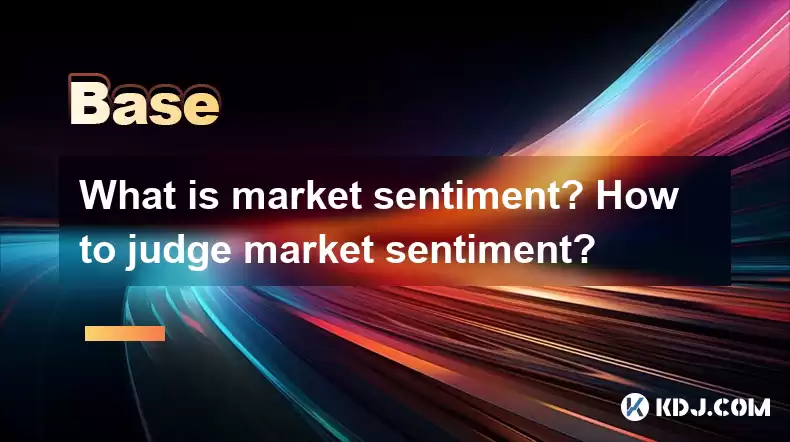-
 bitcoin
bitcoin $99177.955738 USD
-7.32% -
 ethereum
ethereum $3187.183061 USD
-12.38% -
 tether
tether $0.999809 USD
0.00% -
 xrp
xrp $2.117933 USD
-9.42% -
 bnb
bnb $906.710033 USD
-9.17% -
 solana
solana $149.367737 USD
-10.74% -
 usd-coin
usd-coin $0.999816 USD
0.01% -
 tron
tron $0.281498 USD
-0.38% -
 dogecoin
dogecoin $0.156292 USD
-8.00% -
 cardano
cardano $0.500744 USD
-10.19% -
 hyperliquid
hyperliquid $38.087358 USD
-4.58% -
 chainlink
chainlink $14.097831 USD
-8.54% -
 bitcoin-cash
bitcoin-cash $463.329916 USD
-9.22% -
 ethena-usde
ethena-usde $0.999078 USD
-0.01% -
 unus-sed-leo
unus-sed-leo $9.475862 USD
-0.79%
What is market sentiment? How to judge market sentiment?
Crypto market sentiment, a crucial factor influencing price, is judged using quantitative (volume, price action, on-chain data) and qualitative (social media, news, analyst opinions) methods. Understanding this sentiment aids informed decisions, but doesn't guarantee future price predictions.
Mar 17, 2025 at 12:35 pm

- Market sentiment reflects the overall feeling or emotion of investors towards a particular cryptocurrency or the market as a whole. It's a crucial factor influencing price movements.
- Judging market sentiment involves analyzing various on-chain and off-chain data points, including social media trends, news coverage, trading volume, and price action.
- There are both quantitative and qualitative methods to assess market sentiment, each providing unique insights.
- Understanding market sentiment helps traders and investors make more informed decisions, but it's not a foolproof predictor of future price movements.
Market sentiment, in the context of cryptocurrencies, represents the collective feeling or emotion of investors regarding the current state and future prospects of a specific cryptocurrency or the broader cryptocurrency market. This sentiment can range from extreme bullishness (optimism and expectation of price increases) to extreme bearishness (pessimism and expectation of price decreases). It's a crucial factor influencing trading decisions and price fluctuations. Understanding market sentiment is vital for navigating the often volatile cryptocurrency market. It's a gauge of investor confidence and risk appetite.
How to Judge Market Sentiment: Quantitative MethodsSeveral quantitative methods help gauge market sentiment. These methods involve analyzing numerical data to identify trends and patterns.
- Trading Volume: High trading volume often suggests strong conviction, either bullish or bearish, depending on the price action. Conversely, low volume may indicate indecision or lack of interest.
- Price Action and Chart Patterns: Technical analysis, using candlestick patterns, moving averages, and other indicators, can reveal potential shifts in sentiment. For example, a sustained upward trend often points to bullish sentiment, while a prolonged downward trend suggests bearishness.
- On-Chain Data: Metrics like the Market Value to Realized Value (MVRV) ratio, network activity, and the number of active addresses can provide insights into investor behavior and confidence levels. High MVRV ratios often suggest overvaluation and potential bearish sentiment.
- Fear and Greed Index: This widely used indicator summarizes various market factors into a single score reflecting the overall sentiment (fear or greed). High scores indicate greed (bullish sentiment), while low scores represent fear (bearish sentiment).
Qualitative methods rely on subjective assessments and interpretation of non-numerical data.
- Social Media Sentiment Analysis: Monitoring social media platforms like Twitter, Reddit, and Telegram for mentions and discussions around specific cryptocurrencies can reveal prevalent sentiment. Tools can analyze the tone of these conversations to gauge overall sentiment.
- News and Media Coverage: The tone and content of news articles and reports about cryptocurrencies significantly influence investor sentiment. Positive news generally boosts sentiment, while negative news can trigger sell-offs.
- Analyst Opinions and Predictions: Following the opinions and predictions of prominent cryptocurrency analysts and commentators can offer insights into market sentiment. However, remember that these opinions are subjective and not always accurate.
- Community Forums and Discussions: Participating in and observing discussions within online cryptocurrency communities can provide valuable qualitative insights into the prevailing sentiment among active investors.
For a more comprehensive understanding, it's beneficial to combine quantitative and qualitative methods. Quantitative data provides objective measures, while qualitative data offers context and nuance. By integrating these approaches, investors can develop a more holistic view of market sentiment and make better-informed trading decisions. However, remember that even with this combined approach, predicting market movements with certainty remains impossible.
Step-by-Step Guide to Analyzing Market Sentiment:- Identify your target cryptocurrency: Choose the cryptocurrency you want to analyze.
- Gather data: Collect quantitative data (volume, price, on-chain metrics) and qualitative data (social media sentiment, news articles).
- Analyze the data: Use technical analysis tools for quantitative data and sentiment analysis tools for qualitative data.
- Interpret the results: Assess the overall sentiment based on your analysis. Consider whether the data aligns with your own observations and market understanding.
- Develop a trading strategy: Use your analysis to inform your trading decisions. Remember to always manage your risk appropriately.
A: No, market sentiment is not a foolproof predictor. While it significantly influences price movements, it's just one factor among many. Other factors like regulatory changes, technological advancements, and macroeconomic conditions also play a role.
Q: How often should I check market sentiment?A: The frequency depends on your trading style and risk tolerance. Day traders may need to monitor sentiment constantly, while long-term investors might only check it periodically.
Q: Can market sentiment be manipulated?A: Yes, market sentiment can be manipulated through misinformation campaigns, coordinated social media efforts, and other tactics. It's crucial to be aware of potential manipulation and to critically evaluate information sources.
Q: Are there tools to help analyze market sentiment?A: Yes, various tools are available, ranging from simple sentiment analysis websites to sophisticated platforms incorporating multiple data sources and analytical techniques. Many charting platforms also incorporate sentiment indicators.
Q: How can I improve my ability to judge market sentiment?A: Practice analyzing data, stay updated on market developments, learn technical analysis and sentiment analysis techniques, and actively participate in cryptocurrency communities to gain experience and perspective. Remember that consistent learning and critical thinking are key.
Disclaimer:info@kdj.com
The information provided is not trading advice. kdj.com does not assume any responsibility for any investments made based on the information provided in this article. Cryptocurrencies are highly volatile and it is highly recommended that you invest with caution after thorough research!
If you believe that the content used on this website infringes your copyright, please contact us immediately (info@kdj.com) and we will delete it promptly.
- XRP ETF Race Heats Up: FTI Filing Sparks November Launch Buzz
- 2025-11-05 18:45:01
- ICP Price Trendline Breakout: Eyes on $10 Upside Target?
- 2025-11-05 17:25:01
- Bitcoin Price Dive: Market Sell-Off and Crypto Rollercoaster
- 2025-11-05 17:25:01
- Bitcoin's Bearish Blues: Analysts Assess the Downturn
- 2025-11-05 17:30:01
- Momentum, Hype, Launch: Riding the Crypto Rollercoaster, NYC Style
- 2025-11-05 17:30:01
- Bitcoin, Monero, Crypto Presales: Decoding the Trends and Unearthing Hidden Gems
- 2025-11-05 17:30:01
Related knowledge

How do decentralized identity (DID) solutions work?
Oct 14,2025 at 11:36pm
Understanding Decentralized Identity in the Blockchain Ecosystem1. Decentralized identity (DID) solutions are built on blockchain networks, allowing i...

What is the "halving" event for cryptocurrencies other than Bitcoin?
Oct 25,2025 at 12:19pm
Decentralized Exchanges Gain Momentum in 20241. Decentralized exchanges (DEXs) have seen a surge in trading volume as users prioritize control over th...

What is the difference between Near Protocol and Ethereum?
Oct 15,2025 at 08:01am
Near Protocol and Ethereum: Core Architectural Differences1. Near Protocol operates on a sharded blockchain architecture known as Nightshade, which al...

What does it mean for code to be "open source" in crypto?
Oct 12,2025 at 01:54pm
Understanding Open Source in the Cryptocurrency Ecosystem1. In the context of cryptocurrency, open source refers to software whose code is publicly ac...

What is the purpose of a "testnet"?
Oct 12,2025 at 09:01am
Understanding the Role of Testnets in Blockchain Development1. A testnet serves as a parallel version of a blockchain network, designed specifically f...

How to avoid phishing scams in crypto?
Oct 13,2025 at 06:18pm
Understanding Common Crypto Phishing Tactics1. Cybercriminals frequently use fake websites that mirror legitimate crypto exchanges or wallet platforms...

How do decentralized identity (DID) solutions work?
Oct 14,2025 at 11:36pm
Understanding Decentralized Identity in the Blockchain Ecosystem1. Decentralized identity (DID) solutions are built on blockchain networks, allowing i...

What is the "halving" event for cryptocurrencies other than Bitcoin?
Oct 25,2025 at 12:19pm
Decentralized Exchanges Gain Momentum in 20241. Decentralized exchanges (DEXs) have seen a surge in trading volume as users prioritize control over th...

What is the difference between Near Protocol and Ethereum?
Oct 15,2025 at 08:01am
Near Protocol and Ethereum: Core Architectural Differences1. Near Protocol operates on a sharded blockchain architecture known as Nightshade, which al...

What does it mean for code to be "open source" in crypto?
Oct 12,2025 at 01:54pm
Understanding Open Source in the Cryptocurrency Ecosystem1. In the context of cryptocurrency, open source refers to software whose code is publicly ac...

What is the purpose of a "testnet"?
Oct 12,2025 at 09:01am
Understanding the Role of Testnets in Blockchain Development1. A testnet serves as a parallel version of a blockchain network, designed specifically f...

How to avoid phishing scams in crypto?
Oct 13,2025 at 06:18pm
Understanding Common Crypto Phishing Tactics1. Cybercriminals frequently use fake websites that mirror legitimate crypto exchanges or wallet platforms...
See all articles










































































